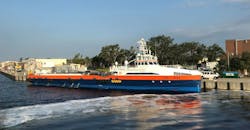Navy Experiments on New Classes of USVs
The U.S. Navy is at work on unmanned vehicles for operation above and below the surface, with contracts to major suppliers such as Boeing for unmanned submarines. In the meantime, this branch of the military has been involved in the development of early-stage unmanned surface vessels (USVs) as part of the Ghost Fleet Overlord program, recently completing Phase 1 of testing on experimental USVs.
Phase 1 involved converting two commercial fast supply vessels into USVs and performing integration of electronic systems that would enable autonomous (self-piloting) operation. More than 600 hours of autonomy testing were performed as part of Phase 1, including several long-range autonomous transits in complex maritime environments. Phase 1 concluded with testing that involved both Overlord vessels executing interactions compliant with the Convention on the International Regulations for Preventing Collisions at Sea (COLREGS).
Phase 2 of the Overlord program commenced with the awarding of contract modifications to a pair of industry teams participating in the program. Phase 2 will involve the integration of government-recommended command-and-control electronic systems by the industry teams. It is scheduled to conclude in fiscal year 2021 with the delivery of the two large USVs to the Navy for further testing. The Overlord program was developed by the Office of the Secretary of Defense Strategic Capabilities Office (OSD SCO) in partnership with the Program Executive Office of Unmanned and Small Combatants (PEO USC).
About the Author
Jack Browne
Technical Contributor
Jack Browne, Technical Contributor, has worked in technical publishing for over 30 years. He managed the content and production of three technical journals while at the American Institute of Physics, including Medical Physics and the Journal of Vacuum Science & Technology. He has been a Publisher and Editor for Penton Media, started the firm’s Wireless Symposium & Exhibition trade show in 1993, and currently serves as Technical Contributor for that company's Microwaves & RF magazine. Browne, who holds a BS in Mathematics from City College of New York and BA degrees in English and Philosophy from Fordham University, is a member of the IEEE.

